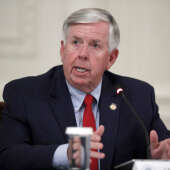Opinion: SEMO economics professor provides a deep dive on inflation

Current economic conditions present several questions to households, business leaders and public policymakers as the year comes to an end. Many are asking why inflation remained stubbornly high for the past two years? And, of course, when will inflation begin to ease?
In order to identify the challenges and opportunities in the current situation, it is important to understand how inflation is measured, as well as its underlying causes.
What is inflation?

Inflation means each dollar of income buys fewer goods and services. In more technical terms, inflation is the percentage change in the cost of living over some period of time. It is usually reported on a monthly or annual basis.
Multiple price indexes exist and can be used to calculate the pace at which the cost of living is changing. Key features that distinguish one price index from another include the types of goods and services that are monitored over time, the relative weights assigned to each product category and the outlets at which price data are collected. Some well-known examples of government-reported price indexes in the United States include the Personal Consumption Expenditures index, GDP deflator and Producer Price Index.
In the era of big data analytics, several private companies also report price data that can complement the information from public sector sources. For example, the software company Adobe reports its monthly Digital Price Index, which focuses exclusively on e-commerce prices.
The most publicized indicator of the cost of living in the United States is usually the Consumer Price Index (CPI). As its name suggests, the CPI’s main objective is to measure how prices paid by consumers change over time. The ‘basket’ of goods and services included in the CPI is determined based on national surveys of households. The selection of the basket is supposed to reflect regular purchases made by a typical urban family of four.
On a monthly basis, prices for goods and services in this basket are collected by the Bureau of Labor Statistics from retail establishments in approximately 75 United States metropolitan areas. This information is used to construct an index number measuring the average level of prices at a given point in time. The inflation rate is created by calculating the percentage change in this index number between two consecutive periods of time.
What causes inflation and why should we care?
What causes inflation? The most concise answer would be the existence of ‘too many dollars chasing too few goods.’ As products and services become relatively scarce in the marketplace, higher prices act as a rationing mechanism to prevent shortages and match sellers with buyers who are willing and able to pay more money. Strong demand for products and services among buyers tends to pull prices upward.
Meanwhile, limitations on supply in the market can also affect the upward impact of prices. The combination of these demand-pull and cost-push effects is a guaranteed recipe for inflation. This is exactly what happened over the past two years.
As 2022 began, the 12-month rate of inflation in the United States was 7.5%, which was the highest rate experienced in our nation since 1982. The root cause of this 40-year high in inflation reflected disruptions that were introduced during the COVID-19 pandemic, as well as the strong economy that preceded it.
The United States economy was experiencing a tight labor market, unemployment at a 50-year low and somewhat high levels of personal savings when the world suddenly experienced the pandemic in 2020. Strong economic conditions entering the pandemic provided some cushion for the negative shocks it presented.
The lockdown months of February through April 2020 brought a sudden halt and sharp decline in economic activity. In the months that followed, the economy rebounded as robust growth in employment and consumer spending coincided with bottlenecks in the global supply chain, which resulted from pandemic-related factory and warehouse shutdowns as well as labor shortages. During the same time period, multiple rounds of fiscal relief packages and a loose monetary policy provided further stimulus to consumer and business spending.
For example, the growth rate in M2, a key measure of the nation’s money supply, grew at a rate of 27% from March 2020 through February 2021. The combination of these factors aligned with the expectation that ‘too many dollars chasing too few goods’ is a reliable path to higher inflation.
For the last 15 years, inflation has been fairly tame, albeit the years 2021 and 2022 have been exceptions. Based on the CPI, the average annual rate of inflation was 1.7% from 2007 through 2020, which would be considered low by historical standards for the United States. At this rate, the cost of living for a typical household would double in approximately 40 years. This pace is a stark contrast to what we have experienced this year.
When compounded over time, single-digit differences in the annual inflation rate can have substantial impacts on our standard of living. If we consider a 9.1% rate of inflation, which was observed during the 12-month period ending in June 2022 as inflation hit a peak, it would only take eight years for the cost of living to double in size. Equally concerning, a 9.1% rate of inflation would exceed the average rate of return on the S&P 500 over the past 20 years, which would make retirement planning a much more daunting task.
Price stability is a term used by economists to describe continuous periods of low inflation, typically between 0% and 3% on an annual basis. Former Federal Reserve Chairman Alan Greenspan once described price stability as “an environment in which expected changes in the cost of living do not significantly alter household or business decisions.”
In other words, households would not hoard excessive savings out of fear that future inflation will erode their living standards. Given the long-term nature of many financial decisions made by households — such as saving for retirement or borrowing to purchase a car or house — predictability and stability in future expenses are likely to influence spending decisions in the present.
Businesses also benefit from price stability when it enables a clearer understanding of future revenues and costs. Less uncertainty in inflation expectations can boost confidence in making present-day expenditures related to hiring new employees or investing in physical assets.
What is the outlook for 2023?
It is hard to imagine further surges of inflation into double-digit levels occurring during 2023. When looking at the current environment, there are key differences when compared to this time last year.
First and foremost, monetary policy has tightened over the past year. The Federal Open Market Committee raised its federal funds rate target, which currently stands at a range of 3.75% to 4%, a total of six times during 2022. Higher interest rates will likely slow spending by consumers and businesses, which should dampen inflation and perhaps the tight labor market as well.
The American consumer has inflation fatigue. Retail spending has struggled to keep up with inflation and the personal saving rate has fallen to its lowest level prior to the Great Recession of 2007 - 2009. Thus far, the holiday shopping season has been characterized by price-sensitive consumers and competitive pressure among retailers to offer deep discounts.
Looking at all these factors, inflation is expected to soften during 2023. While inflation based on the CPI will likely remain above the 2% level experienced during much of the last decade, the changing macroeconomic conditions suggest a slowdown is on the horizon.
David Yaskewich, Ph.D., is a professor of economics at Southeast Missouri State University. He also serves as chairman of SEMO's Accounting, Economics and Finance Department.



























